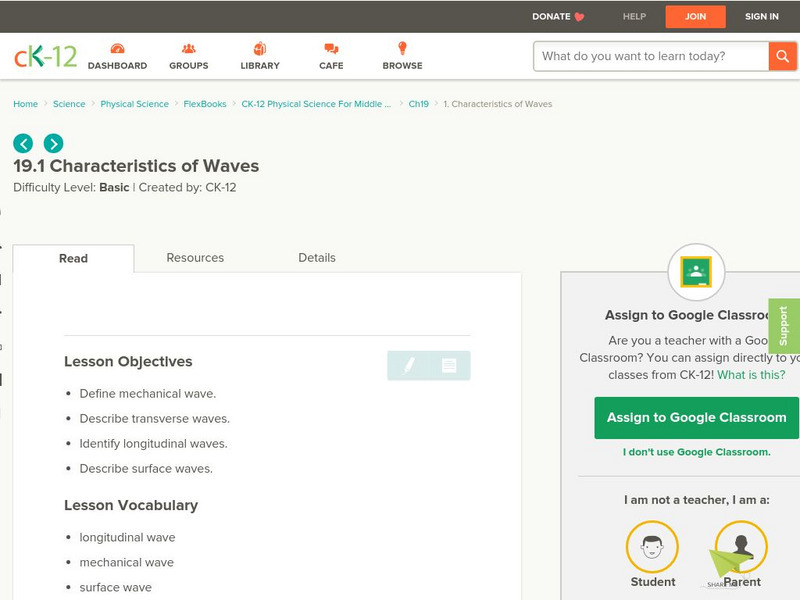Hi, what do you want to do?
Bowels Physics
Waves and Sound
Explore how sound travels as waves with a straightforward lesson that explains the basics of waves in relation to sound. The presentation considers sound waves in both open and closed pipes and shows how to calculate wavelength and...
Curated OER
Wow Waves (Waves on the Fly)
Students formulate hypotheses on wave behavior and test them. In this physics lesson, students compare and contrast transverse and compression waves. They determine the wavelength of transverse waves.
Mr. E. Science
Characteristics of Waves
Waves, waves, and more waves. Here, class members look at the many types and characteristics of energy waves including transverse, longitudinal, standing, seismic, p-waves, s-waves, and l-waves.
Curated OER
Waves
In this waves worksheet, students read about the different types of waves and how the speed of waves is calculated. Then students complete 5 matching, 8 fill in the blank, and 9 short answer questions.
Curated OER
Waves
In this waves worksheet, students read about harmonic and linear motion in waves as well as the two types of waves. They match 5 terms to their definitions about the structure of waves, they solve for the wavelength, frequency and...
Curated OER
Robot Waves
Students differentiate the properties of longitudinal and transverse waves. In this physics lesson, students calculate CEENBoT's rate of propagation by measuring its frequency and distance per cycle. They use a mathematical formula...
Curated OER
Waves
Light waves and sound waves are the focus of this science lesson designed for 5th graders. Besides discovering how these waves travel, learners also discover the basic properties of waves, and analyze data tables and graphs. The...
Nature
Structural Hazards
The scientific explanation of seismic waves is detailed in the introduction. A fictional scenario is also provided for your class to discuss. Pictures and handouts that are meant to be included, however, they are not accessible....
Curated OER
From Bats to Babies: Ultrasound
Learners research and analyze sound waves and how an ultrasound works to image a baby in utero. They explore various websites, complete worksheets, and write a paragraph describing a demonstration they view in the classroom.
Curated OER
A Whole Lotta Shakin'
Students read first hand accounts of earthquake survivors in order to begin the describe the different types of earthquake waves and the order in which they arrive. They engage in using earthquake waves as a means to indirectly study the...
Curated OER
Waves: Understanding the Motion of Waves
Students demonstrate the motion of waves. In this wave lesson, students demonstrate the various attributes to waves and the properties through a variety of hands-on activities.
Other
Transverse and Longitudinal Wave Propagation in an Elastic Medium
Extensive information about how waves behave in an elastic medium. Covers different types of waves, their characteristics and behavior, the anatomy of the ear, the speed of sound in different media, the parts of a wave, and wave phenomena.
Khan Academy
Khan Academy: Wave Characteristics Review
Review the characteristics of periodic transverse and longitudinal waves such as wavelength, crest, trough, amplitude, expansion, and compression.
Physics Classroom
The Physics Classroom: Waves: The Anatomy of a Wave
Students explore the characteristics of both transverse and longitudinal waves.
Khan Academy
Khan Academy: Characteristics of Longitudinal and Transverse Waves
Test yourself on the topics of identifying the characteristics of a longitudinal or transverse wave such as the wavelength, crest, and areas of compression with this multiple choice quiz.
CK-12 Foundation
Ck 12: Physical Science: Characteristics of Waves
[Free Registration/Login may be required to access all resource tools.] Covers three types of mechanical waves - transverse, longitudinal, and surface - and their characteristics. Includes labeled illustrations and two video animations.



















